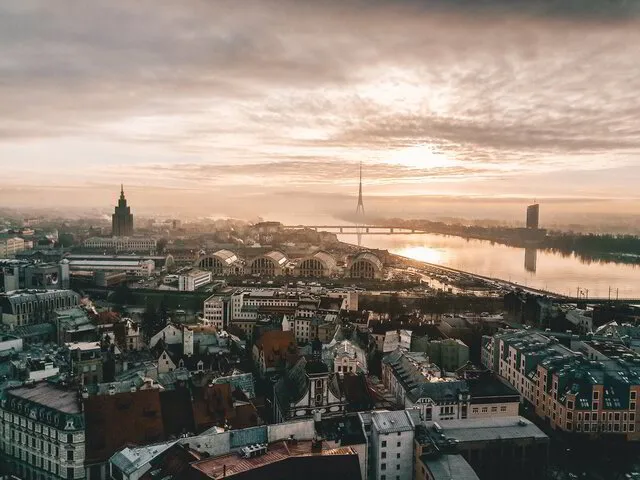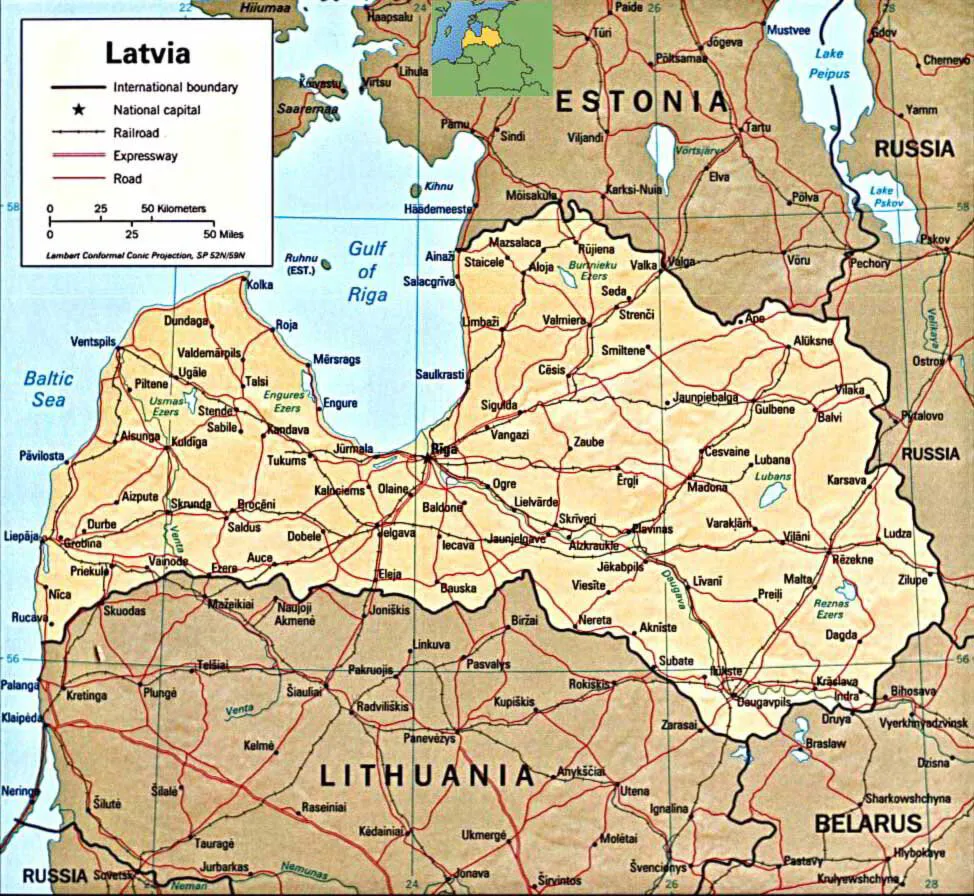Information about Latvia
Location of Latvia
Latvia lies in Eastern Europe and shares its coastline with the Baltic Sea & the Gulf of Riga. It shares land borders with Lithuania, Estonia, Russia & Belarus.
The capital of Latvia – Riga – the largest and most cosmopolitan city in the Baltic States – was founded in 1201. With its handsome integration of medieval and contemporary architecture, Riga is considered the world’s best collection of the Art Nouveau!
Although Latvia is a small country located on the Baltic Sea, it has ancient traditions and a long history dating back to early 9,000 BC. Latvia is an interesting travel destination because of its wide range of leisure and business travel opportunities.
You can enjoy your trip to Latvia in different ways – city sightseeing tours in Riga historical centre, romantic travel in SPA hotels all over the country, or family holiday in the guest houses on the countryside of Latvia.
Riga offers various ways to make your city break unforgettable – great restaurants, pubs and clubs available right in the centre of the city.
Dating back to early in Riga’s history the city has served as a major trading port and a crossroad between Western Europe and the East that is why it’s still very popular between business travelers as well.
If you are interested in history, you should visit the castles located in different places of Latvia.
In Bauska region, which is close to Lithuania border, you can find marvellous baroque examples – Rundale Palace and the pearl of classicism – Mezotne Palace.
Meanwhile on the other side of Latvia, you can find one of the most majestic castle ruins in the Baltic States – Cesis castle ruins.This is just a brief overview of a surprisingly wide array of castle architecture, spanning from early 13th century up to the beginning of the 20th. Come and explore the heritage of Latvia history!
For nature admirers Latvia proposes the serene Gulf of Riga, the open Baltic Sea, nature parks, rivers and lakes with beauteous forests on the shores.
Latvia is situated in Europe’s mixed forest zone. Its geographical position and the presence of the Baltic Sea determine its natural diversity. Here you can find oceanic as well as continental species and many rare and protected plants.
Climate in Latvia
Latvia is located in the temperate climate zone and therefore has four pronounced seasons. Travellers visiting Latvia can enjoy a real winter with subzero temperatures and snow, spring floods, warm summers, and colourful autumns.
The winter in Latvia usually lasts from mid-December to the beginning of March. Air temperature can differ from +5 degrees Celsius all the way down to -30 degrees.
Due to its flat terrain, Latvia is a great place for cross-country skiing. Although there are no high mountains in Latvia, the country has multiple ski slopes where skiers can rent all the skiing equipment they need, as well as hire a skiing coach.
In Latvia, the spring may begin already at the end of February or as late as in late April, and the spring season lasts until the beginning of June. The average air temperature in spring is 0 to +15 degrees.
The summer in Latvia starts in June and continues until September. The average air temperature in the summer is around +19 degrees, but on some days it may rise to +30 degrees. The latter half of the summer may bring sudden thunderstorms.
In the summer, use the opportunity to go on a tour of the Baltic Sea shoreline or have a holiday in the Latvian resort city of Jurmala, known for its white sandy beaches.
The autumn in Latvia lasts from September to December. The average air temperature decreases from +10 degrees in September to 0 degrees in November.
Sometimes at the beginning of the autumn, there is an Indian summer when temperatures rise to up to +20 degrees, whereas the first snow may fall already in October or November.
Languages in Latvia
The Latvian language is the cornerstone of Latvian identity. That is why Latvians cultivate their language. Since the independence of Latvia in 1918, the Latvian language formed into a well-developed, multifunctional language with an established system of styles and developed terminology.
The Russian language is considered to be the second most popular language in Latvia. Thus, Russian speakers can get by quite easily in the centre as well as in the suburbs.
Some citizens speak both languages, some speak both plus English, and some only speak one or the other.
Getting by with English depends on where you are. In the centre of Riga, most younger people are able to speak at least a little English. If you are in a supermarket or a store, and the person serving you looks under 35, then chances they will speak good English are quite high.
If the person you speak to is older, then there is not as much chance you will have someone who can speak English, but anyway, some older people may have some little knowledge of English.
In the city, most people are used to dealing with people who do not have Latvian language skills. Tourists, exchange students and ex-pats are not unusual.
In the markets, you may find less English speakers, so it is useful to learn a few phrases and some numbers to help you.
In Vecrīga or the “old town”, most establishments will be able to deal with English speakers. The further out of town, the less likely people will so easily converse in English.
Some restaurants have English on their menus, some even have separate English menus.
Riga – the capital of Latvia
Riga is one of the top places for great nightlife and adventures. A wide range of entertainment in Riga is available both day and night – there are night clubs in Riga, restaurants, bars all around the city. Moreover, Riga has always been a multicultural city because of its history.
You can see it even in the architecture of Old Riga, where are architectural features of Germany and Russia, Italy, the Netherlands, and other countries. Therefore, guests in Riga feel like at home.
Public Transport In Riga, Latvia
Riga has four methods of public transportation – tram, trolleybus, bus and rail.
Tram, trolley and bus
Public transport operates between 5:30 and 23:30. Timetables, fares and purchase information are available in Latvian and English at www.rigassatiksme.lv.
The web-site also provides information on the price of tickets and where they can be purchased. The tickets can be bought from Ticket trade outlets, Customer service centers, Ticket vending machines and from mobile app as well. There are 3 different types of tickets.
Firstly there are daily tickets:
- 24-hour ticket 5.00
- 3-day ticket 8.00
- 5-day ticket 10.00
Secondly there are monthly tickets:
- One-month ticket 30.00
- One-month ticket for passengers who are eligible for the Riga City Council fare discount* 15.00
Lastly there are time tickets:
- One 90-minute ticket 1.50
- Two 90-minute tickets 3.00
- Ten 90-minute tickets 15.00
STUDENT DISCOUNT: Some universities offer discounts for public transportation, for more info about which universities and process visit www.rigassatiksme.lv.
An e-ticket can be used on all “Rigas satiksme” buses, trolleys and trams, and is a modern and convenient way to pay for public transportation services in the city. An e-ticket allows passengers to save time, and you do not need the exact change to purchase one. It is possible to get information on the various types of e-tickets and prices at www.rigassatiksme.lv in the Latvian andEnglish languages.
Many people use rail transportation to reach different towns of Latvia. The coastal resort town of Jurmala is a very popular destination among locals and tourists, which is only several kilometers outside of Riga’s city limits. It must be taken into account that there are several rail stops in Jurmala.
The most popular are Lielupe, Bulduri, Dzintari, Majori and Dubulti. A one-way ticket to Jurmala station “Majori” costs about EUR 1,40. It is possible to purchase rail tickets at the Railway station ticket-offices. If the station ticket office is closed, or the certain station does not have a ticket office, tickets can be purchased inside the train from the onboard conductor.
However, if purchasing a ticket onboard, only cash is accepted. All necessary information about the time tables, prices, etc. is available on the website www.pv.lv.
Food in Latvia
Nowadays there is a big variety of food in Latvia. Apart from local dishes, you can find Japanese, Chinese, Georgian, Italian, Spanish and some other European cuisines.
Years of Russian rule have inevitably had an impact, and with ethnic Russians making up a quarter of the population, it is not hard to find good Russian fare in Latvia. One of the most popular dishes is pelmeņi, a type of meat dumpling served with sour cream as well as different kinds of pancakes, soups and other specialities.
Latvian cuisine has many interesting and particular dishes, which are definitely worth trying.
Here are the examples of the most popular national food.
Grey peas and speck (pelēkie zirņi ar speķi)
This is the dish considered to be the most Latvian of them all. It is a kind of stew made from a local variety of dried pea (a bit like a chickpea), mixed with fried onion and diced speck.
Black bread
Like most of their northern European neighbours, Latvians love their dense, dark, rye bread, serving it as an accompaniment to most meals. Varieties include īstā rupjmaize (dark rye bread) and saldskābā maize (sweet sourdough rye bread).
Bread soup
Usually, a dessert of bread soup (maizes zupa) seems quite weird for tourists, however, give it a try, anyway. Rye bread is passed through a sieve, mixed with sugar, spices and dried fruits and topped with whipped cream.
Rupjmaizes Trifle
Then there’s rupjmaizes kārtojums, a kind of trifle made from grated rye bread layered with jam and cream.
In spite of the fact that Latvia is located by the sea, the cuisine is not very rich in fish dishes, but still there is something local to taste. Herring is a widespread kind of fish, popular in both cooked and pickled varieties. Smoked sprats in oil are a traditional delicacy in Rīga, and smoked fish shacks dot much of the Latvian coast in summer.
Cost of Living in Latvia
Approximate cost of living in Riga can vary between 400-600 euro including food, transport, phone along with Internet expenses as well as accommodation.






